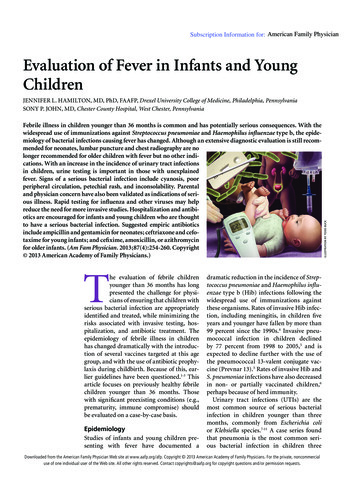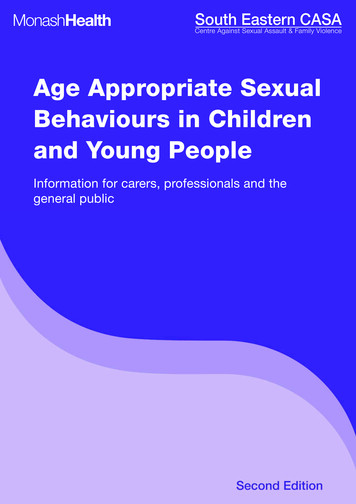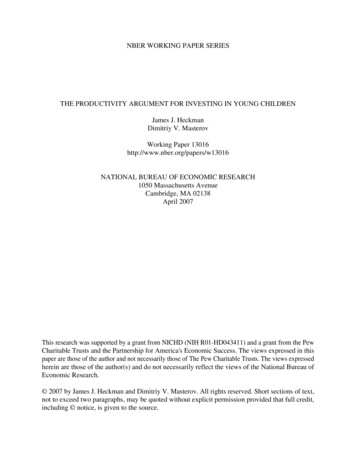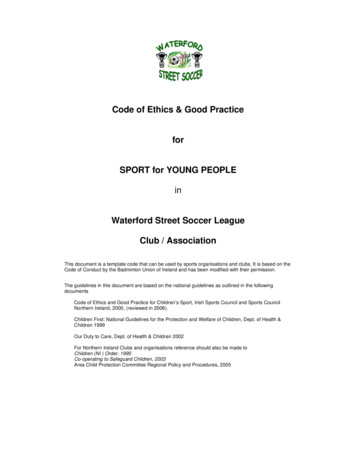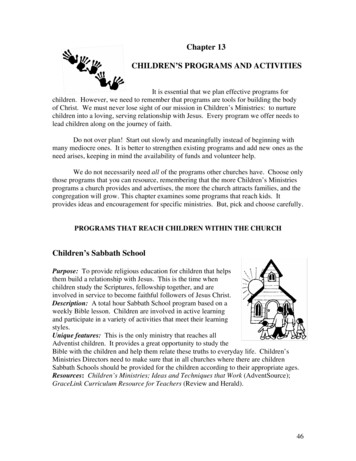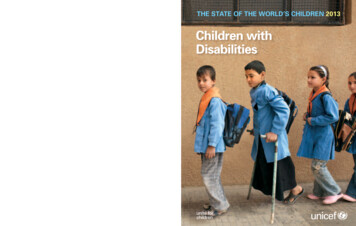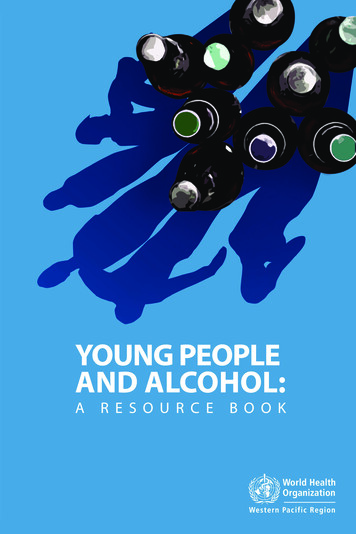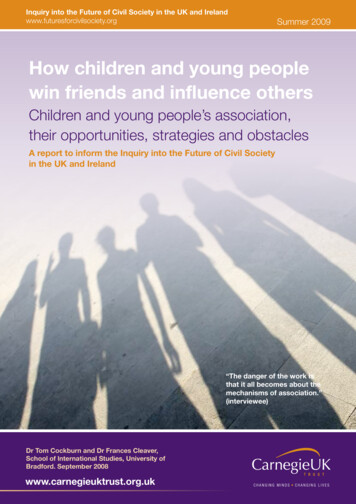
Transcription
1Young Children Develop in anEnvironment of Relationshipsworking paper1
membersJack P. Shonkoff, M.D., ChairJulius B. Richmond FAMRI Professor of Child Health andDevelopment; Director, Center on the Developing Child,Harvard UniversityW. Thomas Boyce, M.D.Sunny Hill Health Centre/BC Leadership Chair in ChildDevelopment; Professor, Graduate Studies and Medicine,University of British Columbia, VancouverJudy Cameron, Ph.D.Professor of Psychiatry, University of Pittsburgh; SeniorScientist, Oregon National Primate Research Center;Professor of Behavioral Neuroscience and Obstetrics &Gynecology, Oregon Health and Science UniversityGreg J. Duncan, Ph.D.Distinguished Professor, Department of Education,University of California, IrvineNathan A. Fox, Ph.D.Distinguished Professor; Director, Child DevelopmentLaboratory, University of Maryland College ParkMegan R. Gunnar, Ph.D.Regents Professor and Distinguished McKnight UniversityProfessor, Institute of Child Development,University of MinnesotaPat Levitt, Ph.D.Director, Zilkha Neurogenetic Institute; Provost Professor ofNeuroscience, Psychiatry and PharmacyChair, Department of Cell and Neurobiology, Keck School ofMedicine of the University of Southern CaliforniaLinda C. Mayes, Ph.D.Arnold Gesell Professor of Child Psychiatry, Pediatrics, andPsychology, Yale Child Study CenterSpecial Advisor to the Dean, Yale School of Medicineross a. thompson, ph.D.Professor of Psychology, University of California, Daviscontributing memberssusan nall balesPresident, FrameWorks Institutewilliam t. greenough, ph.D.Swanlund Professor of Psychology, Psychiatry, and Cell andDevelopmental Biology; Director, Center for Advanced Studyat University of Illinois, Urbana-Champaigneric knudsen, ph.D.Edward C. and Amy H. Sewall Professor of Neurobiology,Stanford University School of MedicineDeborah phillips, ph.D.Professor of Psychology and Associated Faculty, Public PolicyInstitute; Co-Director, Research Center on Children in the U.S.,Georgetown Universityarthur J. rolnick, ph.D.Senior Vice President and Director of Research, FederalReserve Bank of Minneapolisformer membersbetsy lozoff, m.D.Professor of Pediatrics, University of MichiganMedical School; Research Professor. Center for HumanGrowth and Development, University of Michiganpartnersthe frameworks institutethe national governors association center for best practicesthe national conference of state legislaturesBruce S. McEwen, Ph.D.Alfred E. Mirsky Professor; Head, Harold and MargaretMilliken Hatch Laboratory of Neuroendocrinology,The Rockefeller UniversitysponsorsCharles A. Nelson, Ph.D.Richard David Scott Chair in Pediatric DevelopmentalMedicine Research, Children’s Hospital Boston;Professor of Pediatrics and Neuroscience, HarvardMedical SchoolPalix foundationthe birth to five policy alliancethe buffett early childhood fundthe John D. and catherine t. macarthur foundationthe pierre and pamela omidyar fundAbout the AuthorsThe National Scientific Council on the Developing Child, housed at the Center on the Developing Child at Harvard University, is a multidisciplinary collaboration designed to bring the science of early childhood and early brain development to bear on public decisionmaking. Established in 2003, the Council is committed to synthesizing and communicating science to help inform policies that promotesuccessful learning, adapative behavior, and sound physical and mental health for all young children. For more information, go tohttp://www.developingchild.net.Please note: The content of this paper is the sole responsibility of the authors and does not necessarily represent the opinions of thefunders or partners.Suggested citation: National Scientific Council on the Developing Child. (2004). Young children develop in an environment ofrelationships. Working Paper No. 1. Retrieved from http://www.developingchild.net 2004, National Scientific Council on the Developing Child, Center on the Developing Child at Harvard UniversityUPDATED & REPRINTED: OCTOBER 2009
The Issuehealthy development depends on the quality and reliability of a young child’srelationships with the important people in his or her life, both within and outside the family.Even the development of a child’s brain architecture depends on the establishment of these relationships.1, 2, 3, 4, 5, 6Growth-promoting relationships are based onthe child’s continuous give-and-take (“serve andreturn” interaction) with a human partner whoprovides what nothing else in the world can offer– experiences that are individualized to the child’sunique personality style; that build on his or herown interests, capabilities, and initiative; thatshape the child’s self-awareness; and that stimulatethe growth of his or her heart and mind.Young children experience their world asan environment of relationships, and these relationships affect virtually all aspects of theirdevelopment – intellectual, social, emotional,physical, behavioral, and moral. The qualityand stability of a child’s human relationshipsin the early years lay the foundation for a widerange of later developmental outcomes that really matter – self-confidence and sound mental health, motivation to learn, achievement inschool and later in life, the ability to control aggressive impulses and resolve conflicts in nonviolent ways, knowing the difference betweenright and wrong, having the capacity to developand sustain casual friendships and intimate relationships, and ultimately to be a successfulparent oneself.Stated simply, relationships are the “active ingredients” of the environment’s influence on healthy human development. Theyincorporate the qualities that best promotecompetence and well-being – individualizedresponsiveness, mutual action-and-interaction, and an emotional connection to anotherhuman being, be it a parent, peer, grandpar-Young children experience their world as anenvironment of relationships, and theserelationships affect virtually all aspectsof their development.ent, aunt, uncle, neighbor, teacher, coach,or any other person who has an importantimpact on the child’s early development.Relationships engage children in the humancommunity in ways that help them definewho they are, what they can become, and howand why they are important to other people.7, 8, 9, 10, 11, 12, 13In the words of the distinguished developmental psychologist Urie Bronfenbrenner: in order to develop normally, a child requires progressively more complex joint activity with oneor more adults who have an irrational emotionalrelationship with the child. Somebody’s got to becrazy about that kid. That’s number one. First,last, and always.What Science Tells Usnurturing and stable relationships withcaring adults are essential to healthy humandevelopment beginning from birth. Early, secure attachments contribute to the growth ofa broad range of competencies, including alove of learning, a comfortable sense of oneself, positive social skills, multiple successfulwww.developingchild.NETrelationships at later ages, and a sophisticated understanding of emotions, commitment, morality, and other aspects of humanrelationships. Stated simply, establishing successful relationships with adults and otherchildren provides a foundation of capacitiesthat children will use for a lifetime.14, 15, 16, 17Young Children Develop in an Environment of Relationships 1
National scientific council on the developing childThe “serve and return” interaction between parent and baby – in which young children naturallyreach out for interaction through babbling, facialexpressions, and gestures and adults respondwith the same kind of vocalizing and gesturingback at them – builds and strengthens brain architecture and creates a relationship in which thebaby’s experiences are affirmed and new abilities are nurtured. Children who have healthyrelationships with their primary caregivers aremore likely to develop insights into other people’s feelings, needs, and thoughts, which formChildren who develop warm, positive relationshipswith their kindergarten teachers are more excitedabout learning, more positive about coming toschool, more self-confident, and achievemore in the classroom.a foundation for cooperative interactions withothers and an emerging conscience. Sensitiveand responsive parent-child relationships alsoare associated with stronger cognitive skills inyoung children and enhanced social competence and work skills later in school, which illustrates the connection between social/emotionaldevelopment and intellectual growth. Thebroader quality of the home environment (including toys, activities, and interactions within the family setting) also is strongly relatedto early cognitive and language development,performance on IQ testing, and later achievement in school.12, 18, 19, 20, 21, 22, 23, 24, 25, 26Young children also learn a great deal from eachother. They learn how to share, to engage in reciprocal interactions (e.g., taking turns, givingand receiving), to take the needs and desires ofothers into account, and to manage their own impulses. Just being around other children, how-ever, is not enough. The development of friendships is essential, as children learn and playmore competently in the rapport created withfriends rather than when they are dealing withthe social challenges of interacting with casualacquaintances or unfamiliar peers.27, 28The warmth and support of the caregiver in a2 Young Children Develop in an Environment of Relationshipschild care setting also influence the developmentof important capabilities in children, including greater social competence, fewer behaviorproblems, and enhanced thinking and reasoningskills at school age. Young children benefit inthese ways because of the secure relationshipsthey develop in such settings, and because of theways in which the caregivers provide cognitivelystimulating activities and support for developing positive relationships with other children.Unfortunately, the generally poor quality of careprovided in many child care arrangements inthe United States does not support these benefits because of high caregiver turnover, poorlydesigned programs, or inadequate preparationof staff. Current research also suggests the additional risk that a greater amount of time in outof-home care during infancy may be associatedwith greater disobedience and aggression by thetime children enter school.12, 22, 23, 29, 30, 31, 32, 33Relationships are important to school adjustment. Children who develop warm, positiverelationships with their kindergarten teachers are more excited about learning, morepositive about coming to school, more selfconfident, and achieve more in the classroom.Relationships with peers also are important.Children who experience greater peer acceptance and friendship tend to feel more positivelyabout the school experience and perform betterin the classroom.33, 34, 35, 36, 37, 38Children have different ways of interacting withtheir peers. Some are gregarious, others are tooshy to get involved (although they want to),some need time to “warm up,” and others arenot as interested in being sociable. All of thesevariations fall within a normal range, and it isessential to differentiate among the many potential reasons (both biological and environmental)that a young child may have limited or difficultinteractions with others. Playing cooperatively,making friends, and sustaining friendships overtime are not always easy. Any child with severelylimited peer involvement is at considerable riskfor significant adverse developmental consequences.39, 40, 41, 42, 43Secure and stable relationships with caring adults assure that young children are adequately nourished; protected from dangerousillnesses, exposure to toxins, and hazards thatwww.developingchild.NET
what science tells uscan lead to preventable injuries; provided preventive health check-ups; protected from excessive stress; and afforded predictable dailyroutines that convey a sense of security. Theseinfluences contribute significantly to healthybrain development and depend upon the careand support provided by individuals in thecommunity as well as in the family.12, 44Young children are highly vulnerable emotionally to the adverse influences of parental mental health problems and family violence. Oneof the most extensively documented of thesevulnerabilities is the negative impact of amother’s clinical depression on her youngchildren’s emotional development, socialsensitivity, and concept of themselves, effects that have been demonstrated in bothdevelopmental research and studies of brainfunctioning. Young children who grow upin seriously troubled families, especiallythose who are vulnerable temperamentally,are prone to the development of behavioraldisorders and conduct problems.45, 46, 47, 48, 49Animal studies have shown that the quality ofthe mother-infant relationship can influencegene expression in areas of the brain that regulate social and emotional function and can evenlead to changes in brain structure. The natureof the relationship also can have long-terminfluences (into adulthood) on how the bodycopes with stress, both physically and emotionally.15, 50, 51, 52, 53, 54, 55, 56, 57, 58, 59, 60Science indicates that the quality of early parent-child relationships can be strengthened,but successful interventions are more difficultto achieve when relationships are significantlytroubled or disturbed. Preventive interventionsalso can produce a variety of positive outcomes,depending on the extent to which the knowledge and skills of the staff and the quality of theimplementation are matched to the magnitudeof the challenges being addressed. 12, 61, 62, 63, 64, 65Popular Misrepresentations of Scienceas the public’s appetite for scientific information about the development of young children is whetted by exciting new findings, therisk of exaggerated or misleading messagesgrows. Within this context, it is essential thatscientific fact be differentiated from popularlyaccepted fiction.Contrary to common assumptions, scientificevidence shows that the influence of relationships on development continues throughout the lifespan. These relationships are notmore important at a particular stage of a child’slife compared to another, but the nature ofthose impacts does vary by age and developmental status.4In contrast to frequently cited concerns, scienceindicates that young children can benefit significantly from secure relationships with multiple caregivers (within or outside the family),while their attachments to their parents remainprimary and central.13 There is no credible sci-relationships with other nurturing and reliableadults who they trust, especially early in life,interfere with the strength of the young child’sprimary relationship with his or her parents.Although young children certainly can establish healthy relationships with more than oneor two adults, prolonged separations from familiar caregivers and repeated “detaching” and“re-attaching” to people who matter are emotionally distressing and can lead to enduringproblems. There is no scientific evidence to sup-port the belief that frequently rotating relationships with large numbers of adult caregivers provide valuable learning opportunities in the earlyyears of life. Although the importance of sustained, reliable relationships within the family is well understood, the need for stable andpredictable relationships in child care settings is acknowledged less frequently, andthe disruptive impacts of the abrupt changesrelated to high caregiver turnover are too oftendisregarded.66, 67entific evidence to support the claim that closewww.developingchild.NETYoung Children Develop in an Environment of Relationships 3
National scientific council on the developing childThe Science-Policy Gapthe importance of mother-child relationships is old news. The importance of otherfamily relationships (with fathers, siblings, andgrandparents) is semi-old news. The impactof these relationships on the development ofthe brain is new news. And the important influence of relationships outside of the family – with child care providers, peers, teachers,neighbors, and other adults and children in thecommunity – is even newer, because these individuals are often valued more for what theydo than for the meaning of their role in the lifeexperience of very young children. Greater understanding of what science tells us about theimportance of a range of relationships for earlychildhood development leads us to think aboutmany areas of policy and practice in a new light.“Quality” in early child care and education,for example, is often defined in terms of adultchild ratios, group size, physical facilities, and,more recently, cognitively oriented curriculum.But “quality” is perceived differently when weview child care as a prominent feature of theenvironment of relationships in which youngchildren develop. The importance of ensuring that relationships in child care are nurtur-problematic when viewed in relation to extensive scientific evidence of the vital importanceof establishing a strong and healthy mother-infant bond beginning in the early months of life.They elicit even greater alarm when viewed inthe context of concerns about the potential adverse effects on very young babies of early andextended experiences in out-of-home child carearrangements of highly variable quality.71, 72, 73For mothers receiving welfare support underTemporary Assistance to Needy Families (TANF),federal rules require that states impose workrequirements of 30 or more hours per week.Although modifications are permissible, abouthalf of the states do not exempt mothers of children less than 12 months of age, and some statespermit mandated maternal employment beginning a few weeks after a baby’s birth. Whenviewed as an adult-oriented employment policy,TANF can be a subject for reasonable debate.But when examined from a child-oriented perspective, it reflects a wide gap between what weknow about the importance of early family relationships and what we are doing to promotethe health and well-being of our nation’s mostvulnerable young children.74, 75Parental leave policies in the United Statescurrently provide parents of young childrenwith few options.ing, stimulating, and reliable leads to an emphasis on the skills and personal attributes ofthe caregivers, and on improving the wagesand benefits that affect staff turnover.12, 68, 69, 70Parental leave policies in the United States currently provide parents of young children with fewoptions. A maximum of only three months ofunpaid leave is assured for parents of newborns,and these policies cover only about half ofAmerican workers. Of those who are eligible forleave, only those who can get by without earnedincome can afford to take it, and fewer than halfof workers even have this option without risking loss of their jobs. These policies seem highly4Young Children Develop in an Environment of Relationshipswww.developingchild.NET
Implications for policy and programsImplications for Policy and Programsthe science of early childhood development is sufficiently mature to support a number of well-documented, evidence-based implications for those who develop and implementpolicies that affect the health and well-being ofyoung children. Five compelling messages areparticularly worthy of thoughtful consideration:When considered within the context of a child’senvironment of relationships, the concept ofschool readiness is not exclusively a matter offostering literacy and number skills. It must alsoinclude the capacity to form and sustain positive relationships with teachers, children, andother adults, and develop the social and emotional skills for cooperating with others.66, 76, 77When viewed as an important part of a child’s environment of relationships, early childhood education must strive to involve young children in reciprocal learning interactions with teachers andpeers rather than isolated “pre-academic” work,and it should capitalize on children’s natural interests and intrinsic drive to learn, rather thanfollow an adult-determined agenda. Stated sim-ply, young children learn best in an interactive,relational mode rather than through an education model that focuses on rote instruction.78Extending the length and coverage of leave currently provided under the Family and MedicalLeave Act would provide the critical necessities oftime and economic security that are required forparents to develop the nurturing relationshipswith their children that are essential to healthydevelopment. Much can be learned from otherindustrialized nations that promote greater parental choice and child well-being by providingsubsidized parental leave for those who wish tostay at home with their babies, and affordable,decent quality, early care and education for thechildren of those who choose or are compelledto return to work.73, 78In the absence of consistent evidence that maternal employment intrinsically helps or hurts mostchildren, science has little to add to the ongoingpolitical debate about whether paid work shouldbe a mandated requirement for mothers on public assistance. Nevertheless, emerging data thatwww.developingchild.nETsuggest that maternal employment in the firstsix months of an infant’s life may be associatedwith later developmental problems, and concerns about the potential adverse impacts ofextended out-of-home child care experienceson young children’s social development andStated simply, young children learn best inan interactive, relational mode rather thanthrough an education model that focuses onrote instruction.behavior, require thoughtful public discussion.Each raises serious concerns about the potentialharm of mandated maternal employment andthe limited availability of affordable, high quality child care, particularly for the already vulnerable babies of low-income women on publicassistance. It is time for society to weigh the evidence carefully and fashion a more thoughtfulpolicy for parents in the workforce, particularlyfor those who earn low wages.12, 79, 80Traditional child welfare approaches to maltreatment focus largely on physical injury, the relative risk of recurrent harm, and questions of childcustody, in conjunction with a criminal justiceorientation. In contrast, when viewed through achild development lens, the abuse or neglect ofyoung children should be evaluated and treatedas a matter of child health and developmentwithin the context of a family relationship crisis,which requires sophisticated expertise in bothearly childhood and adult mental health. Theregularized referral of suspected cases of childabuse or neglect from the child welfare systemto the early intervention system would assureappropriate developmental and behavioral assessment and treatment as needed. Child abuseprevention strategies that emphasize both thedevelopmental needs of children and the importance of community-based supports forfamilies provide another clear example of howwe can close the gap between science and practice for our most vulnerable young children.12Young Children Develop in an Environment of Relationships 5
National scientific council on the developing childReferences1. Berscheid, E., & Reis, H.T. (1998). Attraction and closerelationships. In D.T. Gilbert, S.T. Fiske, & G. Lindzey(Eds.), Handbook of social psychology, Vol. 1 (2nd Ed.).New York: McGraw-Hill.2. Collins, W.A., & Laursen, B. (1999). Relationships as developmental contexts. The Minnesota Symposia on ChildPsychology, Vol. 30. Mahwah, NJ: Lawrence ErlbaumAssociates.3. Dunn, J. (1993). Young children’s close relationships: Beyond attachment. Newbury Park, CA: SagePublications.4. Reis, H.T., Collins,W.A. & Berscheid, E. (2000).Relationships in human behavior and development.Psychological Bulletin, 126(6), 844-872.5. Dawson, D. , & Fischer, K.W. (Eds.) (1994). Humanbehavior and the developing brain. New York: GuilfordPress.6. Panksep, J. (1998). Affective neuroscience. New York:Oxford.7. Bornstein, Marc (Ed.) (2002). Handbook of parenting(2nd ed.). Mahwah, NJ: Lawrence Erlbaum Assoc.8. Cassidy, J. & Shaver, P.R. (Eds.) (1999). Handbook of attachment: Theory, research, and clinical applications (pp.89-111). New York: Guilford.9. Cochran, M., Larner, M., Riley, D., Gunnarsson, L., &Henderson, C.R., Jr. (1990). Extending families: Thesocial networks of parents and their children. New York:Cambridge University Press.10. Fogel, A. (1993). Developing through relationships: Originsof communication, self, and culture. Chicago: Universityof Chicago Press.11. Rogoff, B. (1990). Apprenticeship in thinking: Cognitivedevelopment in social context. New York: OxfordUniversity Press.12. Shonkoff, J.P., & Phillips, D. (Eds.) (2000). From neuronsto neighborhoods: The science of early childhood development. Committee on Integrating the Science of EarlyChildhood Development.Washington, DC: NationalAcademy Press.13. Thompson, R.A. (1998). Early sociopersonality development. In W. Damon (Ed.), & N. Eisenberg (Vol. Ed.)Handbook of child psychology, Vol. 3: Social, emotional,and personality development. (5th ed., pp. 25-104). NewYork: John Wiley & Sons.14. Belsky, J., & Cassidy, J. (1994). Attachment: Theory andevidence. In M. Rutter & D. Hay (Eds.), Developmentthrough life. (pp. 373-402). Oxford, UK: BlackwellScientific.15. Thompson, R.A. (1999). Early attachment and later development. In J. Cassidy & P.R. Shaver (Eds.), Handbookof attachment: Theory, research, and clinical applications(pp. 265-286). New York: Guilford Press.16. Thompson, R.A. (2000).The legacy of early attachments.Child Development, 71(1),145-152.17. Waters, E., Kondo-Ikemura, K., Posada, G., & Richters,J.E. (1991). Learning to love: Mechanisms and milestones. In M. Gunnar & L. Sroufe (Eds.), Self processes and development. Minnesota Symposia on ChildPsychology,Vol. 23. (pp. 217-255). Hillsdale NJ: Erlbaum.18. Bradley, R.H., Caldwell, B.M. Rock, S.L., & Ramey, C.T.(1989). Home environment and cognitive development in the first three years of life: A collaborative study6 Young Children Develop in an Environment of Relationshipsinvolving six sites and three ethnic groups in NorthAmerica. Developmental Psychology, 25(18), 217-235.19. Bradley, R.H., Caldwell, B.M., & Rock, S.L. (1988). Homeenvironment and school performance: A ten-year followup and examination of three models of environmentalaction. Child Development, 59(2), 852-867.20. Estrada, P., Arsenio,W.F., Hess, R.D., & Holloway, S.D.(1987). Affective quality of the mother-child relationship: Longitudinal consequences for children’s schoolrelevant cognitive functioning. Developmental Psychology,23(2), 210-215.21. Gottfried,A.W., & Gottfried,A.E. (1984). Home environment and early cognitive development. New York:Academic Press.22. Peisner-Feinberg, E.S., Burchinal, M.R., Clifford, R.M.,Culkin, M.I., Howes, C., Kagan, S.I.,Yazejian, . . . Zelazo,J. (2000). The children of the Cost, Quality, and OutcomesStudy go to school: Technical report. Chapel Hill, NC:Frank Porter Graham Child Development Center,University of North Carolina at Chapel Hill.23. Pianta, R.C., Nimetz, S.L., & Bennett, E. (1997). Motherchild relationships, teacher-child relationships, andschool outcomes in preschool and kindergarten. EarlyChildhood Research Quarterly, 12(3), 263-280.24. Kochanska, G., & Thompson, R.A. (1997).The emergenceand development of conscience in toddlerhood andearly childhood. In J.E. Grusec & L. Kuczynski (Eds.),Parenting and children’s internalization of values (pp.53-77). New York: Wiley.25. Thompson, R.A., Meyer, S., & McGinley, M. (2006).Understanding values in relationship: The development of conscience. In M. Killen & J. Smetana (Eds.),Handbook of moral development. Mahwah, NJ: LawrenceErlbaum Associates.26. Kochanska, G. (2002). Mutually responsive orientationbetween mothers and their young children: A context forthe early development of conscience. Current Directionsin Psychological Science, 11(6), 191-195.27. Rubin, K.H., Bukowski,W., & Parker, J.G. (1998). Peer interactions, relationships, and groups. In W. Damon (Ed.)& N. Eisenberg (Vol. Ed.), Handbook of child psychology,Vol. 3: Social, emotional, and personality development (5thed., pp. 619-700). New York: Wiley.28. Rose-Krasnor, L. (1997).The nature of social competence:A theoretical review. Social Development, 6, 111-135.29. Lamb, M.R. (1998). Nonparental child care: Context,quality, correlates. In W. Damon (Ed.), & I.E. Seigel &K.A. Renninger (Vol. Eds.), Handbook of child psychology,Vol. 4: Child psychology in practice. (5th ed., pp.73-134).New York: Wiley.30. NICHD Early Child Care Research Network (2000).Therelation of child care to cognitive and language development. Child Development, 71(4), 958-978.31. NICHD Early Child Care Research Network (2002). Earlychild care and children’s development prior to school entry: Results from the NICHD Study of Early Child Care.American Educational Research Journal, 39(1), 133-164.32. NICHD Early Child Care Research Network (2003). Doesamount of time spent in child care predict socioemotional adjustment during the transition to kindergarten?Child Development, 74(4), 976-1005.www.developingchild.NET
REFERENCEs33. Pianta, R.C. (1999). Enhancing relationships betweenchildren and teachers. Washington, DC: AmericanPsychological Association.34. Birch, S., & Ladd, G. (1997).The teacher-child relationship and children’s early school adjustment. Journal ofSchool Psychology, 35, 61-79.35. Ladd, G.W., Birch, S.H., & Buhs, E.S. (1999). Children’ssocial and scholastic lives in kindergarten: Relatedspheres of influence? Child Development, 70(6),1373-1400.36. Ladd, G.W., Kochenderfer, B.J., & Coleman, C.C. (1996).Friendship quality as a predictor of young children’searly school adjustment. Child Development, 67(6),1103-1118.37. Ladd, G.W., Kochenderfer, B.J., & Coleman, C.C. (1997).Classroom peer acceptance, friendship, and victimization: Distinct relational systems that contribute uniquelyto child
human being, be it a parent, peer, grandpar-ent, aunt, uncle, neighbor, teacher, coach, or any other person who has an important impact on the child’s early development. Relationships engage children in the human community in ways that hel
